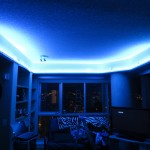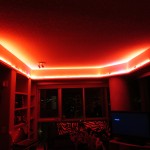2014-06-30 – This (both this post, and the project) is a work in progress. My lights are installed and controllable, the installation is being upgraded, and a better user interface is needed.
Wanted to get into some electronics, and I really need some form of end objective to get going on anything. The thermostat project that was going to be my debut into electronics and microcontrollers has a pretty ambitious scope that has been intimidating enough to procrastinate any serious work on.
When I saw the advertisement form sparkfun with some addressable RGB LED strips for sale (60 WS2812 pixels/m) – I decided to do something with those. With solution in mind, I went looking for a problem.
The crown around my living room has a perimeter around 17m, and I wanted some better lighting in there. At 60pixels/m, 1000 pixels works out to be a nice arbitrary round number that takes up enough space.
A test installation of a few strips from January:



